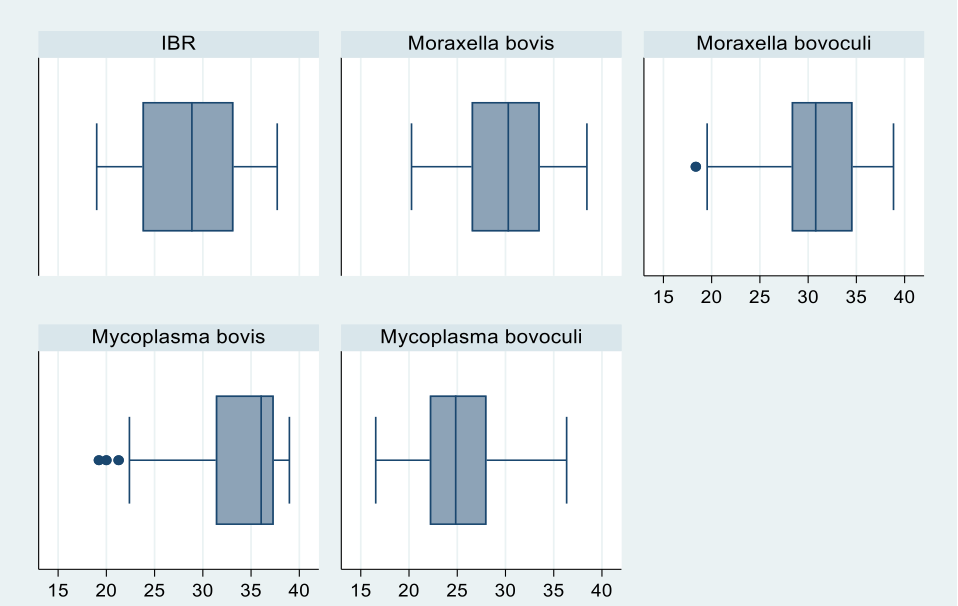
July 2020
Summary of Results from Ocular Swabs Submitted to KSVDL during Fall 2019 for IBK PCR Testing
By Drs. Gregg Hanzlicek and Jianfa Bai
Infectious bovine keratoconjunctivitis (IBK) continues to be a common, sporadic health issue in bovine herds. A recent study estimated that the economic loss to the U.S. beef cattle industry, due to reduced weight gain, treatment costs, and reduced animal sale-value, was over $150 million dollars annually.1 In addition to the economic costs, IBK is also considered an animal welfare issue.2
The descriptive summary below represents the findings from a newly developed PCR panel3 offered to KSVDL clients beginning in the fall of 2019. The summary includes results from 100 ocular swabs representing 29 different herds submitted during the fall of 2019. Both Mycoplasma bovoculi and Moraxella bovoculi were found in a large percentage of eye swab samples, 99% and 88%, respectively. Surprisingly, Infectious bovine rhinotracheitis (IBR) was found in 26% of the samples (Table 1).

|
The number of organisms found within a single ocular swab varied with 50% of the samples containing three organisms and 23% containing four organisms. Two percent of the samples contained all five IBK associated organisms (Table 2).

|
Samples containing multiple combinations of organisms was common (Table 3). In 31% of the samples, Mycoplasma bovoculi and Moraxella bovoculi in addition to Moraxella bovis were present, and 13% of the samples were positive for all four bacterial organisms (Table 3).

|
In almost every KSVDL submission, we identified two or more organisms in the same sample, once again indicating the complexity of this disease. We also found that Mycoplasma bovoculi is the most common organism identified in IBK submissions. These results are similar to other studies.4 To the authors’ knowledge, no clinical studies have been completed that indicate M. bovoculi is an IBK pathogen. However, multiple studies have shown that M. bovoculi increases the colonization of bovine eyes with Moraxella bovis and other bacteria.4,5
Cycle time comparisons between organisms did reveal some differences. The box plots below indicate that the median Ct values for IBR and Mycoplasma bovoculi were much lower than the median Ct values of the other organisms (dark line within the dark box). The median Ct value for Mycoplasma bovis was above 35.
 |
Statistical analysis of median Ct values between organisms did indicate some differences (Table 4).
Table 4. Median Ct values comparisons in 100 ocular swabs representing 29 separate submissions submitted to KSVDL for IBK PCR panel testing during the fall of 2019

|
Medians followed by a common letter are not statistically different at the 5% significance level.
The use of Ct values to assign the level of clinical importance of organisms continues to be controversial. From a practical standpoint, if Ct values are used in addition to other information including clinical signs, histology, etc., it would seem logical that pathogens found in greater numbers (lower Ct values) would be more clinically relevant. It is also plausible that associated pathogen numbers with clinical cases may differ between organisms, with some being more pathogenic than others, and a set significant/not significant Ct value across pathogens species is not appropriate.
Given the few practical IBK prevention methods that are available to veterinarians and their producers, this disease will likely remain an issue in cow-calf herds. The KSVDL IBK panel provides a tool that practitioners can use to identify the associated organisms and plan both present and future disease mitigation programs. This panel also provides the opportunity for practitioners to select the organisms that predominate in those herds pursuing autogenous vaccine production.
References:
- Lane VM, George LW, Cleaver DM (2006) Efficacy of tulathromycin for treatment of cattle with acute ocular Moraxella bovis infections. J Am Vet Med Assoc 229, 557-561.
- Gould S, Dewell R, Tofflemire K, Whitley RD, Millman ST, Opriessnig T, Rosenbusch R, Trujillo J, O’Connor AM (2013) Randomized blinded challenge study to assess association between Moraxella bovoculi and infectious bovine keratoconjunctivitis in dairy calves. Vet Microbiol 164, 108–115.
- Zheng W, Porter E, Noll L, Stoy C, Lu N, Wang Y, Liu X, Purvis T, Peddireddi L, Lubbers B, Hanzlicek G, Henningson J, Liu Z, Bai J (2019). A multiplex real-time PCR assay for the detection and differentiation of five bovine pinkeye pathogens. J Microbiol Methods 160, 87-92.
- Schnee C, Heller M, Schubert E, Sachse K (2015). Point prevalence of infection with Mycoplasma bovoculi and Moraxella spp. in cattle at different stages of infectious bovine keratoconjunctivitis. Vet J 2013(1), 92-96.
- Rosenbush RF, Ostle AG (1986). Mycoplasma bovoculi infection increases ocular colonization by Moraxella ovis in calves. Am J Vet Res 47(6), 1214-1216.
Jianfa Bai, PhD is the Section Head for the KSVDL Molecular Research and Development Laboratory
Gregg A. Hanzlicek, DVM, PAS, PhD is the KSVDL Associate Director and Section Head for KSVDL Outreach and Field Investigations and Client Services